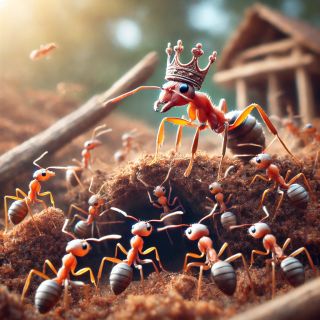Neuroplasticity
Mind Over Matter: Sculpt Your Brain, Transform Your Future
Shape your brain and your future through intentional actions.
Updated July 13, 2024 Reviewed by Davia Sills
Key points
- Research suggests that heavy reliance on technology may change brain structure and reduce grey matter density.
- People can shape their brains through intentional actions to maintain mental agility and resilience.
- Engaging in mentally stimulating activities with new skills can strengthen cognitive function and well-being.
- By balancing technology use with mental activities, people can optimize brain health and cognitive abilities.

Recent fossil and skull studies reveal a surprising trend: Despite a fourfold increase in brain size starting around 2 million years ago, which coincided with major advancements in tool use, social structures, and cognitive abilities, human brains have shrunk by nearly 10 percent over the past few thousand years (DeSilva et al., 2021, 2023). This discovery suggests that as societies became more complex, we developed ways to store information externally through language, writing, and other tools, reducing the need for a massive brain.
But what does this mean for us today?
While brain size isn't everything, this ongoing research raises intriguing questions about intentionally optimizing our well-being. This raises the fascinating possibility: Might we be able to take proactive steps to boost brain power, shape our mental well-being, and maximize our resiliency?
Lessons from highly social insects and beyond
Charles Henry Turner, a pioneering entomologist, revealed in the late 19th and early 20th centuries that ants could learn from their experiences and adapt their behaviors, including following and learning from the trails left by other ants (Turner, 1907). This work highlights how species shape their environments together, learn from each other, and adapt to their surroundings, promoting ongoing learning and driving evolution. In environments with shared knowledge and cooperative roles, larger brains become less necessary, while adaptability and varied cognitive approaches are key to thriving. Beyond ants, humans, and termites, species such as domesticated animals like dogs, cats, and livestock, as well as certain birds and fish, have also shown trends of shrinking brain sizes over time when environmental pressures for complex problem-solving and survival diminish (Kruska, 2005; Sol, 2009; Kotrschal et al., 2013).

Personal neuroplasticity: Shaping our brains with intentional action
While evolutionary changes occur over millennia, we have the power to shape our brains within our lifetimes through the brain's ability to reorganize itself by forming new neural connections. Our experiences and the ways we engage with them can enhance or diminish specific brain functions. This means that the intentional actions we take daily can significantly impact our mental and physical well-being.
For example, if we constantly rely on technology for memory and problem-solving, we may weaken our intrinsic cognitive abilities. Conversely, engaging in mentally stimulating activities can strengthen and expand our cognitive capacities.
A simple yet effective way to do this is to challenge your brain with new routines. Try switching the hand you use for everyday tasks, like brushing your teeth or stirring your coffee. It might feel awkward at first, but this seemingly insignificant change forces your brain to create new neural pathways, enhancing its flexibility and resilience.
Cultivating intentional actions
While directly increasing brain size in adults through current means isn't possible, there are ways to improve brain function that can feel similar to having a "bigger brain." Indeed, we can build our brain's capacity to process information and perform tasks more efficiently to significantly enhance its power.
In today's fast-paced world, bombarded by distractions and information overload, prioritizing brain health is essential. Here are some strategies to help us sharpen our focus, optimize cognitive function, and unlock our full mental potential:
- Engage in mentally stimulating activities: Regularly challenge your brain with new skills, puzzles, and problem-solving tasks. This can enhance cognitive flexibility and resilience.
- Become present through your senses: Studies show that focusing on your senses can act as an anchor to the present moment (Kabat-Zinn, J., 1990). Take a deep breath and notice the subtle aromas in the air. Listen intently to the sounds around you, identifying each distinct noise. Try focusing on a single object and describing it in detail, noticing every color, texture, and nuance. This sensory engagement can enhance your focus and awareness, potentially improving brain function in learning, memory, and emotional regulation.
- Physical activity: Regular exercise promotes neurogenesis and improves overall brain function. It also counteracts the sedentary lifestyle encouraged by modern technology.
- Foster social connections: Meaningful social interactions can boost mental health and cognitive function, mirroring the cooperative behaviors that have historically shaped human evolution.
- Balance technology use: Use technology mindfully. While it can enhance efficiency, ensure it doesn't replace critical thinking and memory exercises.
Reflections on technology and its long-term impact
Technological advancements have undeniably improved our quality of life, but they come with long-term implications. Tools like smartphones and the internet have become extensions of our memory and problem-solving abilities. While this externalization can enhance efficiency, it may reduce our reliance on intrinsic cognitive functions, potentially influencing brain size and function over generations.
Mounting evidence suggests that engaging experiences and technologies can reshape our brains. Activities that challenge our learning, like learning to juggle, can increase the density of gray matter in our brains (Draganski et al., 2004). This principle extends to other activities that challenge memory and cognitive function, such as learning a new language.
Conversely, overreliance on external tools for tasks like navigation or calculations might decrease gray matter density in responsible brain areas. Similarly, the overuse of technology for navigation or passive screen time could shrink the occipital lobe, which is responsible for vision, potentially hindering our ability to navigate independently or appreciate visual details.
Moving forward with intention
As we ride the wave of technological advancements, it's vital to reflect on how this digital revolution will shape our species over time. While directly increasing brain size might not be currently possible, it is crucial to consider our engagement with technology and its impacts on our cognitive function and brain structure.
As a social species, embracing our interconnectedness and leveraging our collective wisdom can harness the benefits of neurodiversity and brain plasticity. Promoting the intentional use of technology may allow us to optimize brain function, mitigate potential negative consequences, and ensure our evolutionary trajectory prioritizes the full potential of the human mind. In doing so, we can shape our brains and lives in ways that truly serve us and our fellow inhabitants of Earth.
References
Bohbot, V. D., McKenzie, S., Konishi, K., Fouquet, C., Kurdi, V., Schachar, R., & West, G. (2015). Virtual navigation strategies from childhood to senescence: Evidence for changes across the life span. Frontiers in Aging Neuroscience, 7, 162.
De Caro, L. (2024). Commentary: Human brains have shrunk: the questions are when and why. Frontiers in Ecology and Evolution, 12, 1368347. doi: 10.3389/fevo.2024.1368347
DeSilva, J., Fannin, L., Cheney, I., Claxton, A., Ilieş, I., Kittelberger, J., Stibel, J., & Traniello, J. (2021). Human brains have shrunk: the questions are when and why. Frontiers in Ecology and Evolution, 11, 1191274. doi: 10.3389/fevo.2023.1191274
Doidge, N. (2007). The Brain That Changes Itself: Stories of Personal Triumph from the Frontiers of Brain Science. Penguin Books.
Draganski, B., et. al. (2004). Changes in grey matter induced by training— newly honed juggling skills show up as a transient feature on a brain-imaging scan. Nature, 427(6972), 311-312.
Henneberg, M. (1988). Decrease of human skull size in the Holocene. Human Biology, 60, 395-405.
Kabat-Zinn, J. (1990). Full Catastrophe Living: Using the Wisdom of Your Body and Mind to Face Stress, Pain, and Illness. Bantam Dell.
Kotrschal, A., Räsänen, K., Kristjánsson, B. K., Senn, M., & Kolm, N. (2013). Extreme sexual brain size dimorphism in sticklebacks: a consequence of the cognitive challenges of sex and parenting? PLOS ONE, 8(1), e63552.
Kruska, D. C. (2005). On the evolutionary significance of encephalization in some eutherian mammals: effects of adaptive radiation, domestication, and feralization. Brain, Behavior and Evolution, 65(2), 73-108.
Maguire, E. A., Gadian, D. G., Johnsrude, I. S., Good, C. D., Ashburner, J., Frackowiak, R. S., & Frith, C. D. (2000). Navigation-related structural change in the hippocampi of taxi drivers. Proceedings of the National Academy of Sciences, 97(8), 4398-4403.
Martensson, J., Eriksson, J., Bodammer, N., Lindgren, M., Johansson, M., Nyberg, L., & Lovden, M. (2012). Growth of language-related brain areas after foreign language learning. NeuroImage, 63(1), 240-244.
Navarrete, A., Reader, S. M., Street, S. E., Whalen, A., & Laland, K. N. (2011). Cooperative brains: Human intelligence as collective cognition. Philosophical Transactions of the Royal Society B: Biological Sciences, 366(1567), 1141-1153. doi: 10.1098/rstb.2010.0318
Sol, D. (2009). The cognitive-buffer hypothesis for the evolution of large brains. In R. Dukas & J. Ratcliffe (Eds.), Cognitive Ecology II. University of Chicago Press.
Traniello, J. F. A., et al. (2022). Brain evolution in ants: a comparative analysis. Journal of Evolutionary Biology, 35(3), 567-578. doi: 10.1111/jeb.13855
Turner, C. H. (1907). A preliminary note on ant behavior. Biological Bulletin, 13(5), 333-342.
Villmoare, B., & Grabowski, M. (2022). Reassessing claims of recent human brain size reduction. Frontiers in Ecology and Evolution, 11, 1191274. doi: 10.3389/fevo.2023.1191274




